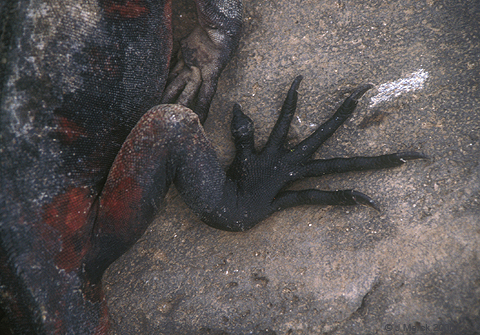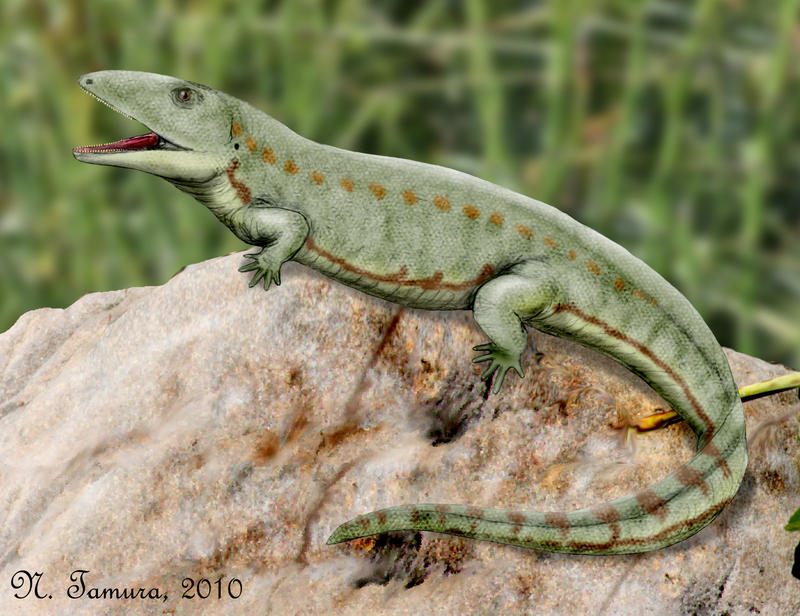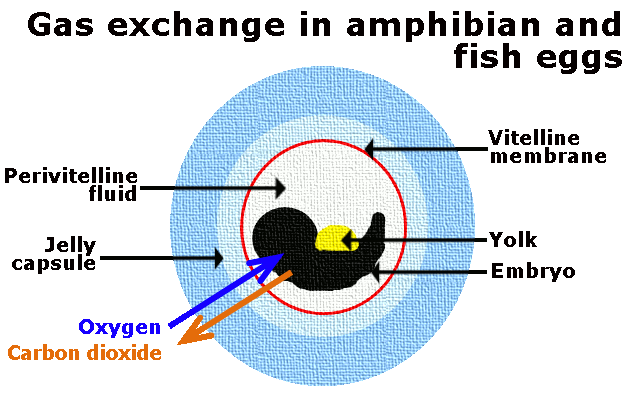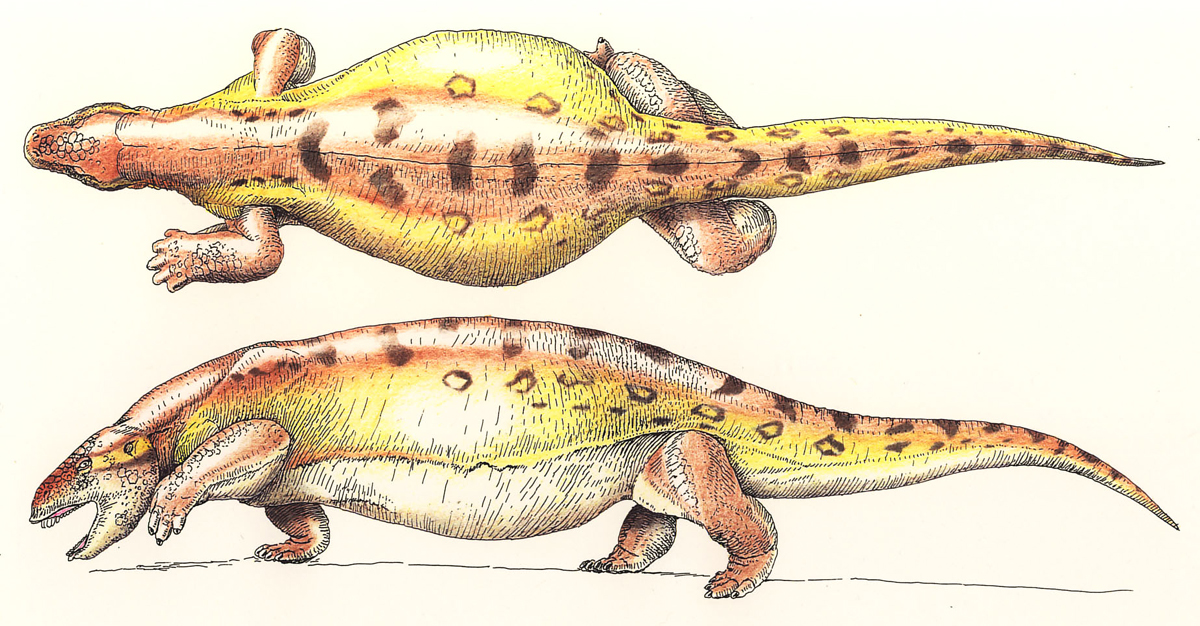Amniota and Basal Synapsida
Based on PowerPoint by Thomas Holtz
Cotylosauria
When we first encounter the amphibian and reptiliomorph lineages in the Early Carboniferous, their members don't look that different, and probably weren't dissimilar ecologically. Even so, even basal members like Caerorhachis (Early Carboniferous - right) possess evolutionary novelties that characterize Reptiliomorpha:
- The elements of the skull roof and cheek are loosely connected in a mobile articulation.
- In the vertebral column, the pleurocentra are larger than the intercentra.
- The tabular bones (forming the corners of the skull roof) contact the parietals. (E.G.: Silvanerpeton. For an example of the amphibian condition see Balanerpeton.)
Like basal amphibians, basal reptiliomorphs show varying degrees of adaptation for life on land, and a range of adaptations, but none are absolutely independent of water. Some interesting highlights that are successively closer to crown-group Amniota:
- Anthracosauria: (Carboniferous - Permian) Largely aquatic medium-large predators. Some have:
- Pleurocentra and intercentra of roughly equal size.
- Seymouriamorpha: (Permian) Terrestrial adults with:
- Stocky bodies and short tails, indicative of adult life on land
- Impedance-matching ears in embayments at the rear of the skull.
- Very large adults incorporate a second sacral rib and lose grooves in skull for lateral line system.
- Lepospondyli: Small tetrapods with solidly coosified (fused) centra and neural arches and reduced skull roof bones in comparison to ancestral forms. (Where else have we seen this?). Major lepospondyl groups:
- Aistopoda: Superficially snake like, elongate, and limbless. Significant reduction of bones of skull roof.
- Nectridia: Long, with short limbs and aquatic, often with bizarre cranial modifications, such as the boomerang - headed Diplocaulus. Note: resting trace fossils left by these animals indicate that the "horns" were connected to the body by a fold of flesh. Sorry, artists.
- Microsaurs: An ecologically diverse variety of small critters, ranging from pedomorphic aquatic forms that retain gills throughout life to forms that, based on limb and body proportions, seem primarily terrestrial.
- Aistopoda: Superficially snake like, elongate, and limbless. Significant reduction of bones of skull roof.
 Discomfort and forebodings: Despite previous claims, some of the physical characteristics of Lepospondyli are potential synapomorphies with Lissamphibia! Indeed, although our consensus cladogram shows us getting very close to Amniota when we discuss lepospondyls, their likely ecologies are disturbingly amphibian-like. As a result, although a solid consensus exists about the non-lissamphibian tree, Lissamphibia are significant wild-cards. For the record, three views exist about Lissamphibian phylogeny:
Discomfort and forebodings: Despite previous claims, some of the physical characteristics of Lepospondyli are potential synapomorphies with Lissamphibia! Indeed, although our consensus cladogram shows us getting very close to Amniota when we discuss lepospondyls, their likely ecologies are disturbingly amphibian-like. As a result, although a solid consensus exists about the non-lissamphibian tree, Lissamphibia are significant wild-cards. For the record, three views exist about Lissamphibian phylogeny:
- Monophyletic Lissamphibia nested within Temnospondyli (the majority view expressed by Ruta et al. 2003)
- Monophyletic Lissamphibia nested within or sister-taxon to Lepospondyli (Laurin, 1997)
- Polyphyletic Lissamphibia (!) with Anura and Caudata nested within Temnospondyli and Gymnophiona nested within or sister-taxon to Lepospondyli (Anderson, 2007)
The terrestrial enigma: Although we have climbed closer and closer to the last common ancestor of Amniota - the true land vertebrates, we see no real trend toward terrestriality. Indeed, Seymouriamorphs, the most terrestrial of the lot as adults, definitely had water-breathing larvae. What are the evolutionary dynamics of this transition? First, consider the end point:
 Amniota: (Carboniferous - Recent) The most recent common ancestor of mammals and birds and all of its descendants. Amniotes represent a major departure in the evolution of full terrestriality in vertebrates, and are the first vertebrates fully to break the dependance on bodies of water.
Amniota: (Carboniferous - Recent) The most recent common ancestor of mammals and birds and all of its descendants. Amniotes represent a major departure in the evolution of full terrestriality in vertebrates, and are the first vertebrates fully to break the dependance on bodies of water.
- Synapomorphies:
- The amniotic egg: An air-breathing egg characterized by a shell and extraembryonic membranes. These enclosed the amniote embryo in a private pond during its development and mediated gas-exchange with the external environment.

Amblyrhynchus cristatus the Galapagos marine iguana - Claws or nails at the end of digits. This novelty allows digging, and burying of eggs. (So are these characters fully independent?)
- An egg-tooth on the snout to facilitate hatching. (Again independent?)
- Complete loss of water-breathing larva.
- Complete loss of lateral line system
- Internal fertilization by means of a penis.
- Two sacral vertebrae.
- Formation of the astragalus (a large tarsal that articulates with the tibia) from the fusion of at least three previous tarsals.
In a way, claiming that these are seven separate characters seems dishonest since all but the last two are associated with one important life-style change: All amniotes reproduce using an air-breathing egg or its derivative.
This is huge. The egg of a lissamphibian is relatively small and simple. The embryo develops inside the perivitelline space enclosed by a Vitelline capsule, outside of which is a thick jelly capsule. Gas exchange is a limiting factor. Gasses enter and leave the egg by simple diffusion. Complicating this, the eggs are often laid in a gelatinous mass where diffusion through the egg mass is slow. Embryos have comparatively low metabolic rates and must hatch at an early developmental stage so as not to asphyxiate.
Major features of the amniotic egg:- It is an air-breathing egg, in contrast to those of other vertebrates.
- Components of the egg:
- A semipermeable leathery or calcareous shell.
- Albumen (and other proteins)
- Three extraembryonic membranes:
- Chorion: Encloses the embryo, yolk and other membranes. Facilitates gas exchange with exterior.
- Amnion: Encloses the embryo
- Allantois: Receives nitrogenous waste products from embryo (including CO2) and facilitates gas exchange. It develops into the urinary bladder.
- Yolk sack Encloses the yolk mass and facilitates the transfer of water and nutrients to the embryo.
- Large reserve of yolk compared to anamniotes. Lissamphibians divide the yolk mass between the various body cells through complete cleavage of the ovum (see earlier lecture). In amniotes, the yolk mass is too large for this. Thus, while the animal pole of the zygote cleaves, forming a disk of cleaving cells on the surface of the yolk, the yolk, itself, doesn't.
- This arrangement has been variously modified. In placental mammals, the yolk and shell are suppressed, and the membranes modified into the placenta and umbilical cord. In birds and crocodylians, the shell membrane is heavily calcified to form a rigid shell.
- Enable embryos to develop more quickly and to a greater extent prior to hatching.
- Free animals from dependency on bodies of water for reproduction and larval stage.
- Reduce competition for pools of water in which larvae can mature
- Avoid predation on larvae by aquatic predators.
The odd reproductive strategies of some frogs reflect that they, too experience these selective pressures. Some colorful examples:- Foam nests (result)
- Mouth/stomach/vocal sac brooding
- Direct development
But these strategies require very specific environments and/or make heavy demands of parents. The amniotic egg, while metabolically expensive, can be laid and forgotten. Scenarios of it origin are, necessarily, speculative, but the general consensus is that its precursor would have been:
- a relatively large egg, like that of oviparous caecilians (right). It would have:
- required some kind of membrane to hold it together
- needed to be internally fertilized
- required the embryos to employ some kind of gas-exchange structure (like the gills of caecilian embryos.)
- laid by a relatively small animal, capable of finding moist microclimates.
- The amniotic egg: An air-breathing egg characterized by a shell and extraembryonic membranes. These enclosed the amniote embryo in a private pond during its development and mediated gas-exchange with the external environment.

life without gills:
As we've seen, the presence of gills is a positive liability for any animal seeking to spend time on land. With the rise of Amniota, we are definitely dealing with animals that do not use gills at any life stage. Their loss entailed a new set of problems.Two-chambered hearts:
Fish-like vertbrates have a straightforward cirulatory system in which blood:
- Returns from the tissues and is gathered in an atrium which contracts when it is full, pushing the blood into the
- Ventricle which contracts powerfully to propel the blood back to the itssues where its first stop is the
- Gills in which it picks up a full load of oxygen.
Three-chambered hearts:

Among lungfish and tetrapods, for whom the lungs are an important source of oxygen, a set of blood vessels have become specialized to take blood from the ventricle directly to the lung, then back to the atrium. In lungfish, the atrium is partly partitioned. In tetrapods, it is completely divided into a left and right atrium, receiving oxygenated blood from the lungs and deoxygenated blood from the body respectively. This blood gets mixed in the ventricle, but this is not a problem in lungfish (or any ancestral stegocephalian that relied to any degree on gills), since its next stop is the gills, anyway. For exclusively air-breathing tetrapods, however, it is a big problem, because it means that blood reaching the body is usually not completely oxygenated.
Four-chambered hearts:

Among some amniotes, this problem is solved by the evolution of a heart in which the ventricle, in addition to the atrium, is completely divided. Thus, deoxygenated blood follows this course:
- Tissues to right atrium
- Right atrium to right ventricle
- Right ventricle to lungs, where it becomes oxygenated
- Lungs to left atrium
- Left atrium to left ventricle
- Left ventricle to tissues.
The four-chambered heart has evolved twice among amniotes:
- In the lineage leading to mammals
- In the lineage leading to the common ancestor of Archosauria whose living members include crocodylians and birds.
The common ancestor of amniotes is unknown. The earliest fossil amniote, Hylomonus dates from the Late Carboniferous (312 mya). From the Carboniferous and Permian we have fossils of candidates for its sister-taxon, including:
- Diadectomorpha (Latest Carboniferous - Early Permian) Including the unspecialized predatory Limnoscelis and Tseajaia, and the the dog-sized Diadectes (right), the first known tetrapod herbivore. These lack claws, however Diadectes and some relatives show fusion of the astragalus as adults but not as juveniles. Aquatic larvae are unknown for them and they represent the first group with large terrestrial adults.
Looking farther back in time to the Carboniferous, we see:
- Westlothiana (Early Carboniferous - 335 mya) Small (snout-vent length ~115 mm.), long, and thin, this creature resembles amniotes in its loss of certain skull bones and the strong ossification of its slender limbs. First published as "the first amniote," continued study has cast doubt on its close relationship. This much seems clear: For a very early reptiliomorph, it is closer to the ancestry of amniotes than one might expect.
- Casineria (Early Carboniferous - 340 mya) Small (snout-vent length ~100 mm.) known from a single headless specimen. Has well-ossified slender limbs and fingers and toes ending in claws. This and Westlothiana suggest that the lineage leading to amniotes was well established by the end of Romer's Gap.
And note that Casineria and Westlothiana are both in the size range that our speculation on the origin of the amniotic egg leads us to expect.










